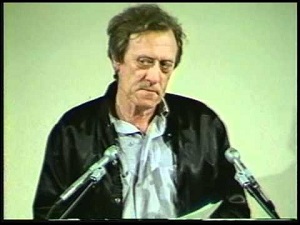De Amerikaanse dichter en letterkundige Ed Dorn werd geboren op 2 april 1929 in Villa Grove, Illinois. Hij groeide op in armoede op het platteland tijdens de Grote Depressie. Hij bezocht acht klassen lang een school die bestond uit slechts één klaslokaal. Later studeerde hij aan de Universiteit van Illinois en aan Black Mountain College (1950-1955). Op Black Mountain kwam hij in contact met Charles Olson, die zijn literaire wereldbeeld en zijn beeld van zichzelf als dichter sterk zou beïnvloeden De examinator van Dorn op Black Mountain was Robert Creeley. Samen met hem en met de dichter Robert Duncan behoorde Dorn tot een trio van jongere dichters dat later geassocieerd werd met Black Mountain en met Charles Olson. In 1951 verliet Dorn Black Mountain en reisde hij naar de Pacific Northwest, waar hij met zijn handen ging werken en zijn eerste vrouw, Helene, ontmoette; zij keerden terug naar het college in het najaar van 1954. Na het afstuderen en na twee jaar reizen vestigden zij zich in de staat Washington, waar zijn autobiografische roman “By the Sound” zich afspeelde. In 1961 aanvaardde hij zijn eerste baan in het onderwijs aan de Idaho State University, waar hij het tijdschrift Wild Dog publiceerde. Zijn eerste dichtbundel “The Newly Fallen” werd gepubliceerd in 1961. In 1965 bracht Dorn met fotograaf Leroy Lucas de zomer door met het bezoeken van reservaten van Indianen voor een boek in opdracht van William Morrow & Co. Press, “The Shoshoneans”. In de herfst nodige de Britse dichter en geleerde Donald Davie hem uit aan de faculteit Letterkunde die hij aan het oprichten was aan de nieuwe universiteit van Essex. Hij bracht het grootste deel van de volgende vijf jaar in Engeland door, waar hij verschillende dichtbundels publiceerde en Boek 1 van “Gunslinger schreef”. Hij begon ook samen met Gordon Brotherston aan vertalingen uit het Latijns-Amerikaans, sloot een hechte vriendschap met de Britse dichter J.H. Prynne, en ontmoette zijn tweede vrouw, Jennifer Dunbar. Na zijn terugkeer in de Verenigde Staten doceerde Dorn in jaren 1970 aan meer dan een half dozijn universiteiten in het hele land. In 1977 aanvaardde hij een hoogleraarschap aan de Universiteit van Colorado in Boulder, waar hij voor de rest van zijn leven bleef doceren. In de jaren 1990, na een uitwisselingsbezoek aan de Paul Valery University in Montpellier begon hij te werken aan “Languedoc Variorum: A Defense of Heresy and Heretics”. Ook schreef hij een lang verhalend gedicht “Westward Haut.” Tijdens de laatste twee en een half jaar van zijn leven schreef hij de gedichten van de postuum gepubliceerde “Chemo Sabe”, een verslag van zijn behandelingen voor kanker. Dorns magnum opus, is “Gunslinger”. “Gunslinger” is een lang gedicht in vijf delen. Deel 1 werd voor het eerst gepubliceerd in 1968, en de laatste volledige tekst verscheen in 1974. Andere belangrijke publicaties omvatten: “The Collected Poems: 1956-1974”, “Recollections of Gran Apacheria”, “Abhorrences”, “High West Rendezvous: A Sampler” en “Way More West: New and Selected Poems”.
If It Should Ever Come
And we are all there together
time will wave as willows do
and adios will be truly, yes,
laughing at what is forgotten
and talking of what’s new
admiring the roses you brought.
How sad.
You didn’t know you were at the end
thought it was your bright pear
the earth, yes
another affair to have been kept
and gazed back on
when you had slept
to have been stored
as a squirrel will a nut, and half
forgotten,
there were so many, many
from the newly fallen.
Ode on the Facelifting of the “statue” of Liberty
Abhorrences
4 July, 1986
America is inconceivable without drugs
and always has been. One of the first acts
was to dump the tea. The drug that furnished
the mansions of Virginia was tobacco,
a drug now in much disrepute.
Sassafras, a cure-all, is what they came for
and they dealt it by the bale altho it
was only a diaphoretic to make you perspire—
people were so simple in those days.
The Civil War saw the isolation of morphine
making amputation a pleasure and making
the block of wood between the teeth,
which was no drug, obsolete. Morphinism
was soon widespread among doctors and patients.
At this date interns, the reports tell us,
are among the premier drug ab/users
of said moralistic nation. “Rock” stars
(who notoriously “have” doctors)
consume drugs by the metric ton
even as they urge teenagers to Say No.
The undercurrent of American history
has been the running aches and pains
of the worn path to the door of the apothecary
to fetch cannabis and cocaine elixirs
by the gallon. It has been all prone
all seeking Florida, Ponce de León
was just the beginning of a statistical curve
whose only satisfaction would be total vertigo.
His eager search for youth has become our
frantic tilt with death and boredom,
in fact we are farming death in Florida
with far greater profit than we are
farming food in Iowa—elixirs are as multiform
as the life-style frauds we implore,
a cultural patchwork fit for a fool
in the only country in the world
with a shop called the Drug Store.

Ed Dorn (2 april 1929 – 10 december 1999)
